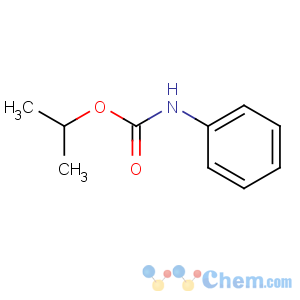Title: Propham
CAS Registry Number: 122-42-9
CAS Name: Phenylcarbamic acid 1-methylethyl ester
Synonyms: carbanilic acid isopropyl ester;
N-phenyl isopropyl carbamate; isopropyl carbanilate;
O-isopropyl
N-phenyl carbamate; INPC; IPC; isoPPC
Molecular Formula: C10H13NO2
Molecular Weight: 179.22
Percent Composition: C 67.02%, H 7.31%, N 7.82%, O 17.85%
Literature References: Prepn: Allen,
US 2615916 (1952 to Columbia-Southern Chem. Corp.); Kovalenko,
Zh. Obshch. Khim. 24, 1041 (1954); J. L. Hermanson, R. Olson,
Trans. Kans. Acad. Sci. 64, 231 (1961). Acute toxicity: T. B. Gaines, R. E. Linder,
Fundam. Appl. Toxicol. 7, 299 (1986).
Properties: Crystals, mp 90°. Practically insol in water. Sol in most organic solvents. LD50 in male, female rats (mg/kg): 3724, 4315 orally (Gaines, Linder).
Melting point: mp 90°
Toxicity data: LD50 in male, female rats (mg/kg): 3724, 4315 orally (Gaines, Linder)
Use: Herbicide, applied as a spray to the soil.

